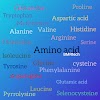Isoleucine | Introduction | History | Structure | Biosynthesis pathway | Function....
ISOLEUCINE AMINO ACID
Introduction-
Isoleucine (symbol Ile or I) is an α-amino acid that is used in the biosynthesis of proteins. It contains an α-amino group, an α-carboxylic acid group, and a hydrocarbon side chain with a branch.
Or
L-isoleucine is the L-enantiomer of isoleucine. It has a role as a Saccharomyces cerevisiae metabolite, an Escherichia coli metabolite, a plant metabolite, a human metabolite, an algal metabolite and a mouse metabolite.
It is an aspartate family amino acid, a proteinogenic amino acid, an isoleucine and a L-alpha-amino acid. It is a conjugate base of a L-isoleucinium. It is a conjugate acid of a L-isoleucinate. It is an enantiomer of a D-isoleucine. It is a tautomer of a L-isoleucine zwitterion. It is classified as a non-polar, uncharged (at physiological pH), branched-chain, aliphatic amino acid. It is essential in humans, meaning the body cannot synthesize it, and must be ingested in our diet. Isoleucine is synthesized from pyruvate employing leucine biosynthesis enzymes in other organisms such as bacteria. It is encoded by the codons AUU, AUC, and AUA. Inability to break down isoleucine, along with other amino acids, is associated with maple syrup urine disease. Isoleucine is one of nine essential amino acids in humans (present in dietary proteins), Isoleucine has diverse physiological functions, such as assisting wound healing, detoxification of nitrogenous wastes, stimulating immune function, and promoting secretion of several hormones. Necessary for hemoglobin formation and regulating blood sugar and energy levels, isoleucine is concentrated in muscle tissues in humans. Isoleucine is found especially in meats, fish, cheese, eggs, and most seeds and nuts.
Properties :-
Chemical formula :- C6H13NO2
Molar mass :- 131.175 g·mol−1
Thermodynamic data :- Phase behaviour (solid–liquid–gas)
STRUCTURE -
HISTORY :-
Isoleucine can be synthesized in a multistep procedure starting from 2-bromobutane and diethylmalonate. Synthetic isoleucine was originally reported in 1905 by French chemist Louis Bouveault. German chemist Felix Ehrlich discovered isoleucine in hemoglobin in 1903.
SYNTHESIS :-
Biosynthesis - As an essential nutrient, it is not synthesized in the body, hence it must be ingested, usually as a component of proteins. In plants and microorganisms, it is synthesized via several steps, starting from pyruvate and alpha-ketobutyrate. Enzymes involved in this biosynthesis include:
1) Acetolactate synthase (also known as acetohydroxy acid synthase)
2) Acetohydroxy acid isomeroreductase
3) Dihydroxyacid dehydratase
4) Valine aminotransferase
Catabolis - Isoleucine is both a glucogenic and a ketogenic amino acid. After transamination with alpha-ketoglutarate the carbon skeleton is oxidised and split into propionyl-CoA and acetyl-CoA. Propionyl-CoA is converted into succinyl-CoA, a TCA cycle intermediate which can be converted into oxaloacetate for gluconeogenesis (hence glucogenic). In mammals acetyl-CoA cannot be converted to carbohydrate but can be either fed into the TCA cycle by condensing with oxaloacetate to form citrate or used in the synthesis of ketone bodies (hence ketogenic) or fatty acids.
Insulin resistance - Isoleucine, like other branched-chain amino acids, is associated with insulin resistance: higher levels of isoleucine are observed in the blood of diabetic mice, rats, and humans. Mice fed an isoleucine deprivation diet for one day have improved insulin sensitivity, and feeding of an isoleucine deprivation diet for one week significantly decreases blood glucose levels. In diet-induced obese and insulin resistant mice, a diet with decreased levels of isoleucine and the other branched-chain amino acids results in reduced adiposity and improved insulin sensitivity. In humans, a protein restricted diet lowers blood levels of isoleucine and decreases fasting blood glucose levels.
Sources :- Even though this amino acid is not produced in animals, it is stored in high quantities. Foods that have high amounts of isoleucine include eggs, soy protein, seaweed, turkey, chicken, lamb, cheese, and fish.







0 Comments